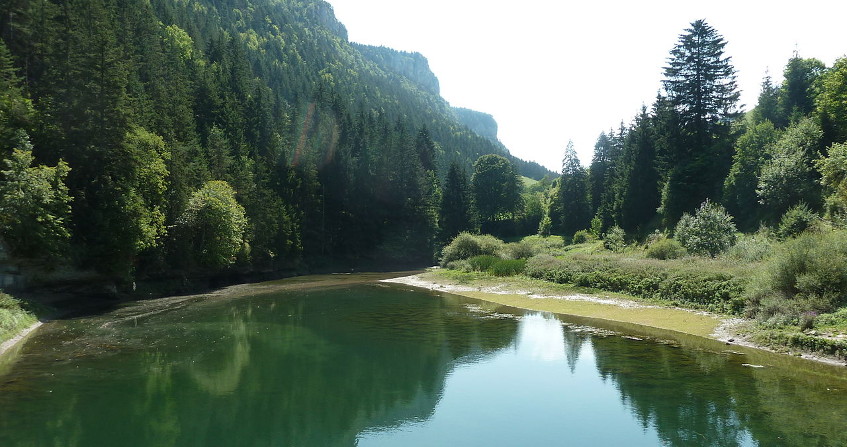天然矿泉水

根据法律规定,天然矿泉水是完全来自于地下的水,可以从泉眼或钻井中获取。天然矿泉水可用于瓶装饮用和/或热疗(温泉治疗)。由于地质原因天然矿泉水被隔绝,因此天然矿泉水水质纯净,矿物成分非常稳定,在装瓶或热疗使用前不需要任何化学处理或消毒。根据定义,这些水来自高度稳定的含水层,通常较深,在某些情况下含有碳。这些含水层通常位于不太容易受到人为活动(密集型农业、工业、城市化等)影响的区域,得益于其地质覆盖层以及在适当情况下制定的专门保护政策,它们受到了很好的保护,免受地表污染。它们为当地经济发展做出了重大贡献。
1. 来自远方的水
从史前时代开始,至少从古代开始,人类就已认识和寻找矿泉水和温泉水(指比该地区常见泉水温度高的泉水)。它们长期以来一直是药典的一部分(AFSSA,2008[1])。公元前五世纪,在古希腊,医生们已经推荐饮用“天然矿泉水”(NMW)并将其用作治疗,因为他们认为这些水具有治病疗效。这一传统在罗马和阿拉伯文明中得以延续,他们会在泉水现场直接饮用(图1)或在浴室中使用这些水。因此,正是罗马人在西方建造了第一座温泉浴场,从而使人们对治疗水的崇拜永久化。
1.1 在法国悠久的历史

在法国,对温泉水的兴趣在中世纪依然持续。所有的温泉甚至在1549年通过亨利二世签署的专利特许证转变为国家财产[1]。1605年,亨利四世通过设立矿泉水监管局,首次对整个王国的温泉水和疗养水实行国家管制。路易十五在1772年确认这一权利的同时,也承认泉眼所在土地的所有者的权利。当时,很少有土地所有者认可和尊重温泉国有化,他们私下开采从他们土地上涌出的泉水。这一问题在1781年通过议会的一项决议得到了最终解决,该决议区分了哪些属于国家财产而哪些属于个人财产,后者在皇家医学会授权后,土地所有者可以在遵守现行法规的情况下对这些水加以利用。
直到19世纪初,法国才真正制定了监管和监测天然矿泉水的法律。当时采取的措施旨在控制水质,保护其物理性质和治疗性能,并确保有序地建立温泉浴场,以便使投资获得足够的经济回报。由于通过钻井开发集水区内的温泉资源以及“泉水战争”(不同业主(所有人)在多处钻井开发同一矿泉水或温泉水资源)的增多,自1856年起,该法律还允许在每个水源周围建立保护周界,以保护其流量。在该范围内需附有强制性要求的对公众公开的利益声明(DIP)。
在16世纪的法国,天然矿泉水除用于热水浴以外,还装瓶供洛林公爵饮用[1]。1632年,路易十三颁布的一项法令授权用密封蜡瓶运输天然矿泉水。1709年已然形成对瓶装天然矿泉水的运输和销售的垄断,相关从业人员须由部门总管授权。经过其他几次修改后,1957年颁布了一项法令,这项法令规定天然矿泉水的运输、处理和装瓶须经部长授权。最后,适用于天然矿泉水的立法依据出现在 2004年8月9日颁布的第2004-806号法案中,该法案基于公共卫生法典中L.和R.1322-1等条款编制。该法律于2007年重新制定。
事实上,瓶装水市场是在19世纪和20世纪初发展起来的。一开始,人们在治疗结束时带水回家,渐渐地人们养成了将天然矿泉水带回家继续治疗的习惯[1]。在法国,大型瓶装水公司出现在第二次世界大战前不久,而市场也随后发展起来。

如今,(在法国)有88种天然矿泉水被认可,并出现在欧洲官方名单上[2]。因为几种不同的水可以在同一地点开采装瓶,因此大约有60个生产地点(图2)。
2014年,法国的包装水产量约为120亿升[3],其中包括约70亿升瓶装天然矿泉水(BMS)和50亿升泉水。法国虽然不是欧洲瓶装水销售的主要市场,但却是世界领先的天然矿泉水出口国,其出口量占世界的三分之一以上[4]。这一瓶装水行业在全国范围内创造了许多就业机会,通常在农村地区[4]:
- 直接提供了10,000个与瓶装水行业相关的工作岗位。
- 间接提供了30,000个工作岗位(不包括与温泉有关的相关工作)。
这些工作大多无法重新安置。本质上,它们依托于泉水,因为天然矿泉水在包装之前无法运输。它们促进了原本闭塞地区的活力,在这些地区,资源的开采往往是唯一的工业活动。
例如,在沃尔维奇(代号63),两家瓶装水厂雇佣了近900人,而当地居民人口仅略高于4,000。韦尔热泽市(代号30) 的情况类似,该市有3,700人口,生产Perrier的南部雀巢公司(Nestlé Waters Sud)位于该市,雇佣了1000多名员工。
瓶装水行业并没有割断它与温泉产业的联系,而且在许多地方,同一矿泉水资源支撑着这两种不同类型的活动。这些地方包括康特雷斯维尔、依云、Thonon-les-Bains、Vichy、Vittel。因此,据专家称,温泉疗养又创造了10,000个直接工作岗位,约50,000个间接工作岗位(住宿、餐饮等)和同样多的关联工作岗位(贸易、休闲、旅游等)。温泉疗养仍然强烈依赖于天然矿泉水品牌的生命力(CSEM,2014)。
1.2 严格的法律法规
目前,在法国,天然矿泉水的定义取自于《公共卫生法典》和《欧洲法规》[5]中的定义[6](EFBW,2017年)。2007年的法令随后在2007年、2010年和2013年进行了5次补充[4],涉及公共利益声明申请的准备、保护区的分配、授权申请的准备、水质标准、健康控制和水监测分析等。
在此背景下,根据《公共卫生法典》第1322-2节,对天然矿泉水(MNE(译者注:是法语eau minérale naturelle的首字母缩写))的一般定义如下:
“天然矿泉水是卫生健康的水……开采自位于地下的地下水源,通过天然泉眼或者通过钻井进行开采。由此可知,在已知自然波动的范围内,其基本特征,特别是其成分和采出时的温度,是稳定的,不受采出水流量的影响。
它不同于其他供人类饮和用的水:
- 按其性质,因所含矿物质、微量元素等成分不同而区别于其他水
- 由于在地下水源中时就很纯净,这两种特性都被完好地保存下来,因为这种水来自地下,没有任何被污染的风险。

根据法规的规定,天然矿泉水可以制成包装饮用水(瓶装水)、输配至公共场所的龙头中供公众使用(图1)或在水疗中心用于治疗目的(图3)。
一直到20世纪80年代初,特别是在法国,法规还要求(须由医学院出具)证明天然矿泉水具有声称的治疗特性。在当前欧洲法规框架下,不再需要证明天然矿泉水具有治疗特性。然而,在这一法规演变之前批准的天然矿泉水都必然会被人们认为具有治疗价值。
世界上一些国家对天然矿泉水没有特别的规定。于是,瓶装天然矿泉水(BMS)的定义则基于食品标准(标准号108-1981)。该食品标准是由联合国粮食及农业组织(FAO)和世界卫生组织(WHO)于1963年建立的,旨在制定统一的国际食品标准,以保护消费者健康,并促进国际食品贸易中的公平操作[7]。
2. 位于地下,健康,且稳定
因此,在操作层面,天然矿泉水是位于地下的,健康且稳定的。
2.1. 地下

它完全来自于地下,从泉水(地下水的天然出口;图4)或通过钻井(通常是垂直的一口井,到达含有地下水的岩石层即含水层,并将其泵出)获取。因此,地表水(例如从河流或湖泊中取用的水)不能瓶装成天然矿泉水(也不能称为泉水;它在法国只能以“已经过处理能够饮用的水”的名义装瓶)。
2.2. 健康
它必须是卫生健康的,即:不得含有致病微生物,尤其是与人类或动物污染有关的微生物。由于天然矿泉水(EMN)不需要消毒和/或存放处理(例如像往自来水里那样添加氯),或任何其他化学处理,它不是无菌的,因此含有天然菌群。然而,由于地下水中,特别是深层地下水中的营养物质含量较低,因此菌群数量有限。
因为没有消毒/存放处理,这对天然矿泉水的运营商在操作上造成了影响:(在水源、钻孔等处的)收集装置必须由符合食品标准且耐清洗的材料制成(例如不锈钢)。他们需配备能够防止一切污染(特别是空气中的微生物、地表水或人类的污染)的设备(例如空气过滤器,水泥、防侵入设备等)。装置还必须能够(并且是)定期维护(消毒),以避免含水层的微生物群在其内部发展。与使用地下水为水源的市政供水相比,这些预防措施是一个重大区别。
为了保证卫生学上的纯净度,并避免人类、微生物或其他污染,用于生产天然矿泉水的含水层必须得到良好的保护,防止任何水从地表渗入。天然矿泉水都能作到这一点,这要归功于他们的自然地质保护。例如,在依云-班(Haute-Savoie),这种保护是由地下几十米厚的不透水岩石(冰川成因的冰碛石底部)提供的。
2.3. 稳定
“其基本特征的稳定性”(温度、矿化度…)是定义天然矿泉水的关键要素之一,这也将其与“泉水”区分开来。而“泉水”是另一类型的瓶装水,它对基本特征的稳定性没有要求。在操作层面,这意味着只有具有高稳定性、循环缓慢(通常超过多年持续时间)的含水层才能够被认定为具有天然矿泉水的状态。地表水体并非如此,它们经常被雨水补给“稀释”;而喀斯特(石灰岩岩溶)含水层则被湍急的水流稀释;河流冲积区的水也不同,它们经常与河水进行交换。
矿化过程(矿物盐类自然溶解于水中)是通过地下水与其流经路径中的岩石之间的相互作用实现的:水缓慢溶解其流经过的岩石(成分),并通过接触与岩石达到(溶解)平衡。对于天然苏打水(见第3节),底土中存在的二氧化碳会强化这些水-岩相互作用,并促进矿物的溶解。深层地下水温度较高,也会促进矿物的溶解。主要是由于这些溶解的矿物质使天然矿泉水具有治疗作用。因此,对于天然矿泉水来说,其中的一些溶解性矿物质甚至可能超过饮用水标准。无论如何,这种矿化完全是天然来源的;瓶装天然矿泉水(BMS)不能人工添加矿物质。
为了长期维持瓶装天然矿泉水(BMS)的纯净度和稳定性,可能需要在矿物含水层的地表、补给区或集水区实施保护措施(见第5节)。
尽管某些天然矿泉水以非常缓慢的循环为特征,也因此在泉眼或钻井开采时已经经历了很长的年代(几十年甚至几千年),但它们也是自然水循环的一个组成部分。因此,必须以可持续的方式对其进行管理,特别是要确保从泉眼或通过钻井方式抽取的水量不超过以降水(雨水、融雪等)形式经集水区自然补充的水量。
3. 或多或少被矿化
天然矿泉水的矿物成分(或“水化学相”)反映了其所经过岩石的性质(因此也反映了岩石的矿物学成分)。对于某些矿物元素,例如硅或镁,还反映了其在地下流动的持续时间。除了水分子的某些同位素特征(这与雨水或融雪水渗入时的海拔高度等有关)外,原雨水的成分完全被随后矿化过程所掩盖。
因此,在钙质(石灰石)岩石中循环的水通常含有大量的钙,如果石灰岩是白云石质的,甚至含有镁。硫酸盐通常与蒸发岩(例如石膏)的存在或硫化物的浸出有关。如果不是因为蒸发的原因(因此与氯化物相关),高浓度的钠通常反映了在地下深处花岗岩或变质岩中的长期水-岩相互作用。与沉积岩相比,花岗岩、变质岩或火山岩中地下水的溶解二氧化硅含量更高。旨在通过其中矿物成分来描述地下水流动特征的学科称为水文地球化学。
由于底土性质和每种天然矿泉水特征之间的这种密切关系,“风土”一词也经常用在天然矿泉水上。
根据其中矿物盐的含量(即水在180 °C下蒸发后的残留物重量),天然矿泉水分为三类(见2009年6月18日颁布的第2009/54/EC号指令[8]):
- “非常低的矿物质含量”:矿物盐含量小于50 mg/L(如卡姆山、鲁库斯山的天然矿泉水);
- “弱矿化度或含少量的矿物质”:矿物盐含量低于500 mg/L(例如Aizac、Chantemerle、Ventadour、Perrier、Luchon、Sail-les-Bains、Ogeu、Esource du Roy、Aix-les-Bains、依云等地的天然矿泉水);
- “富含矿物盐”:矿物盐含量高于1500 mg/L(如La Ferrugineuse Incomparable, La Reine des Basaltes, Vals-Vivaraise, Quézac, Hydroxydase, Rozana, Saint-Diéry, Sainte-Marguerite, Saint-Antonin, Hépar, Contrex, Cilaos等地的天然矿泉水)。
鉴于某些天然矿泉水的特殊性质,可能会针对某些生理或病理条件给出适用人群或(反过来说)禁忌人群。欲了解更多信息,可参考美国国家医学科学院关于天然矿泉水在食品中的恰当位置的报告(Queneau和Hubert,2006[9])。
值得一提的是显得尤为特别的天然苏打水。最近被作为研究案例(特别地分析其二氧化碳和矿泉水的同位素组成)的巴多伊特泉(卢瓦尔),是天然苏打水形成过程的代表。在位于Massif Central的这一地方,地壳断裂并变薄。这种变薄导致地幔上升到大约15公里的深度。它的部分熔融导致二氧化碳(CO2)脱气,二氧化碳能以气态形式在地壳裂缝中上升。
在大约2.5到3公里的深度,这些气态二氧化碳溶解到从地表渗入的、有至少20,000年水龄的水中。然后这些富含溶解性二氧化碳的水通过地壳裂缝再次上升。由于CO2增强了水-岩相互作用,使得该水获得了很高的矿化度。在上升过程中,它们会遇到两种类型的裂缝:一些裂缝允许它们继续上升;另一些则由于其性质(特别是裂缝的厚度),导致水在深处脱气,唯一能上升的是气体形式的二氧化碳。
在其上升过程的最后几百米处,这些富含溶解CO2和气态CO2的水,分别与那些储藏在花岗岩中的、矿化度较低的水混合和分离,后者大多数的水龄也超过100年。正是在这些100到300米深的花岗岩中,这种天然水混合物被钻井开采,然后装瓶。
4. 或高或低是热水
在上述巴多伊特泉的例子中,深层水的上升流速非常缓慢。因此,天然矿泉水有足够时间在上升期间逐渐冷却;因此,在地表,其温度并不明显高于该区域地表其他来源水的温度。但需要知道的是,当你沉入地下时,平均来说,每100米温度会升高3°C。

资料来源:Marie Via Flickr(https://www. 闪烁。COM/PHOTOS/LESMONTSDORE/5480875713)和F.BILLON]
当上升速度更快时,在深处已加热的矿泉水没有时间冷却那么多。它到达地表时很热。这就是所谓的温泉。当水的温度高于所在区域内浅泉或浅层含水层的温度(即该位置的年平均气温)时,水被认为是热的。例如,在Chaudes–Aigues地区的坎塔尔,温泉的温度达到82℃;至少从12世纪起,这种资源就被用来为家庭供暖(图5)。在瓜德罗普岛的Boiling,地表温泉水的温度接近100°C,在1000米处能达到250°C。已通过钻井开采这些热水来驱动蒸汽涡轮机发电。然后我们谈到地热能(阅读地热能:一种重要的能源?)。
一些化学元素,例如硅,能指示水在地下深处曾经历过的温度,因此也能指示水曾经达到的深度,即使该矿泉水在上升到地表时已部分或完全冷却。这些化学元素被称为“地温计”。例如,通过这些地温计的运用,可以确定巴多伊特水的渗入深度为2.5至3 km。
5. 持续不断的保护和管理
如上所述(第2节),天然矿泉水是自然水循环的一个组成部分,因此必须以可持续的方式进行管理,以确保水资源的量化可持续性。
为了保持天然矿泉水的长期稳定性和纯净度,瓶装水开发商已经为其水源的补给区(或集水区)制定了“保护政策”。集水区是指一个区域,在该区域上部分降落的雨水(和/或融雪)渗入底土,流入矿物含水层,从而贡献于水资源的更新。换句话说,在补给区域上的每一滴降水都可能会进入到矿物含水层中;而在该区域以外的每一滴降水最终可能会补给其它地下水,但在任何情况下都不会补给有关的矿物含水层。

例如,在依云[10],流域面积约为35 km2(图6)。据估计,由于蒸发,更重要的是由于植物的蒸腾作用,50%的大气降水以水蒸气的形式重新返回大气中。约35%的水在地表流走或流入浅层非矿泉地下水体。因此,只有15%的雨水补给了矿物含水层。
一个原创模型已经发挥了近30年的作用,该模型的目的是确保对该补给区域的保护以及依云水纯净度的可持续性,同时促进加沃特高原这一地区的发展。成立于1992年的依云矿泉水补给区保护协会(APIEME)[11]是一个真正的“地方水议会”。它包括位于补给区域中的九个市镇的市长、四个矿泉水产地所在市镇的市长以及装瓶水公司(SAEME)。该协会的任务是资助那些有助于能有效长期保护天然矿泉水资源的项目。近几十年来实施的一些项目包括:升级改造农村污水收集管网和处理站;支持维持传统农业(包括Abondance、Reblochon和Tomme cheeses的AOC/AOP[12](译者注:AOC是指在法国生效的农产品原产地标识保护,AOP是指在欧盟范围内都生效的农产品原产地标识保护。)),这些传统农业几个世纪以来在该地区一直很活跃,因此证明了其在保护天然矿泉水方面的有效性;保护高原上的湿地,根据RAMSAR公约[13],这些湿地现在被冠以“具有国际重要性的湿地”的标签;等等。
APIEME三分之二的资金由瓶装水公司SAEME提供,三分之一由拥有依云天然矿泉水集水区的市政当局提供。根据法国税法,后者受益于特定的财政资源(天然矿泉水附加税)。正是由于其特别的功能,APIEME还领导建立了一项经济再分配政策,该政策以技术丰富的项目群为基础。基于对该地区的准确了解,这些项目必须是多方共赢的(对于瓶装水行业、矿泉水产地所在市政以及补给区保护者)。这些项目是涉及多部门的(农业、城市规划、卫生、自然资源保护等),完全由集体行动组成。它们不包括例如发生在农业部门的“每公顷”补贴。它们不会产生任何(特别是为SAEME服务的)土地征用政策。
这一“保护模式”已应用于在法国的达能集团其它天然矿泉水瓶装厂(Volvic[14]、Badoit[15]、La Salvetat[16]),并为保护位于世界各地的达能集团其它水源提供了灵感。雀巢集团,例如Vittel[17],开发了其它类型的“保护模式”,其目的与保护天然矿泉水资源相同。
参考资料及说明
封面照片:依云-班的前温泉浴场[来源:H.Schmelzle]
[1]法国食品安全局(2008年)。天然矿泉水安全评估指南。AFSSA报告,92页,https://www.anses.fr/fr/system/files/EAUX-Ra-EauxMinerales.pdf
[2]成员国认可的天然矿泉水清单(2013/C 95/03)。
http://eur-lex.europa.eu/LexUriServ/LexUriServ.do?uri=OJ:C:2013:095:0038:0108:EN:PDF,最近更新18/09/15
[3]卫生总局(2016年)。法国水质调节水的质量。2014年数据。基于区域卫生机构提供的健康控制!!!! http://social-sante.gouv.fr/IMG/pdf/bilan_ec_2014__vf_.pdf
[4]矿泉水联合会(CSEM,2014年)。天然矿泉水。可在https://eaumineralenaturelle.fr/查询。
[5]2007年1月11日关于人类饮用水安全的第2007-49号法令
[6]2009年6月18日关于开采和销售天然矿泉水的第2009/54/EC号指令
[7]http://www.fao.org/fao-who-codexalimentarius/about-codex/fr/
[8]欧洲瓶装水联合会(EFBW,2017年)。可在http://www.efbw.org/查询。
[9]昆诺,P.,休伯特,J.(2006)。矿泉水在饮食中的位置(矿泉水作为日常饮食的一部分)。美国国家医学科学院公报,第190卷-12月-第9期,2013-2021页。
http://www.academie-medecine.fr/wp-content/uploads/2013/03/2006.9.pdf
[10]http://www.evian.fr/decouvrir_evian/created_by_nature/a_nee_source_at_the_heart_of_the_alps.html
[11]http://www.apieme-evian.com/
[12]受控原产地名称(AOC)/受保护原产地名称(AOP)
[13]http://www.ramsar.org/fr
[14]http://www.volvic.fr/protegee_by_man/gererer_durably_the_resource.html
[15]http://www.badoit.fr/#/
[16]http://www.lasalvetat.fr/creee_by_the_nature/the_salvetat_a_nee_source_in_the_natural_park_of_the_high_languedoc.html
[17]https://eaumineralenaturelle.fr/dev-durable/protection-de-la-ressource-en-eau
环境百科全书由环境和能源百科全书协会出版 (www.a3e.fr),该协会与格勒诺布尔阿尔卑斯大学和格勒诺布尔INP有合同关系,并由法国科学院赞助。
引用这篇文章: LACHASSAGNE Patrick (2024年3月9日), 天然矿泉水, 环境百科全书,咨询于 2025年1月30日 [在线ISSN 2555-0950]网址: https://www.encyclopedie-environnement.org/zh/eau-zh/natural-mineral-waters/.
环境百科全书中的文章是根据知识共享BY-NC-SA许可条款提供的,该许可授权复制的条件是:引用来源,不作商业使用,共享相同的初始条件,并且在每次重复使用或分发时复制知识共享BY-NC-SA许可声明。








